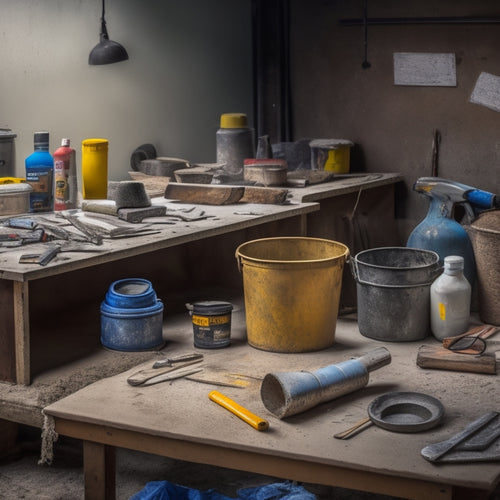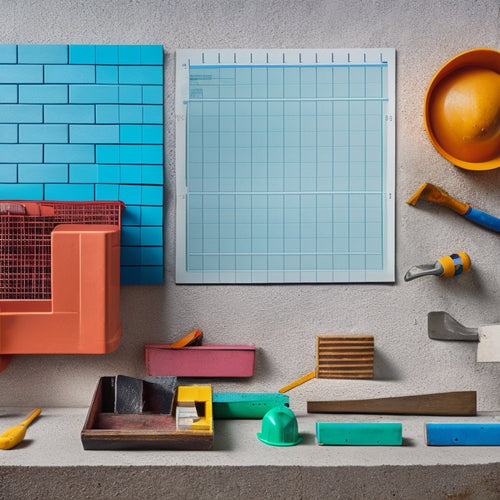
7 Must-Have Tools for Concrete Crack Injection
Share
When tackling concrete crack injection, you'll need the right tools to achieve long-lasting repairs. Start with concrete crack assessment equipment, including a crack width gauge, illumination tools, and a magnifying glass. A high-pressure injection pump, such as an electric or pneumatic pump, is also fundamental. Don't forget an epoxy material handling system, a drill bit and mixer set, and a portable injection resin gun. A flexible hose and tube system will help you navigate tight spaces, while a sealer and adhesion promoter kit guarantees a strong bond. With these 7 must-have tools, you'll be well-equipped to tackle even the toughest concrete crack injection jobs - and understanding how to use them effectively is just the beginning.
Key Takeaways
- A high-pressure injection pump is crucial for concrete crack injection, with options including electric, pneumatic, hydraulic, and manual pumps.
- A portable injection resin gun with adjustable flow control, variable speed trigger, and high-pressure capability is essential for precise repairs.
- A drill bit and mixer set, including diamond-coated or carbide-tipped drill bits and paddle, drill, or static mixers, is necessary for preparing resins.
- A flexible hose and tube system is vital for maneuvering in tight spaces and corners, while resisting abrasion and extreme temperatures.
- A sealer and adhesion promoter kit, including primer, cleaner, and activator, is necessary for creating a strong bond between sealant and concrete.
Concrete Crack Assessment Equipment
To assess the severity of cracks in your concrete structure, you'll need a few specialized tools, including a crack width gauge, which helps measure the width and depth of the cracks. This gauge is a vital assessment tool in crack detection methods, as it provides accurate measurements that inform your repair strategy.
In addition to a crack width gauge, you'll also need a flashlight or lamp to illuminate the crack, a magnifying glass or loupe to examine the crack's surface, and a camera to document the crack's location and severity.
When selecting assessment tools, consider the type of crack you're dealing with. For example, if you're working with hairline cracks, a more precise gauge may be necessary.
It's also important to choose tools that are durable and easy to use, as you'll likely be working in tight spaces or at heights. By investing in the right assessment tools, you'll be able to accurately identify the severity of cracks in your concrete structure and develop an effective repair plan.
This will help you achieve a successful concrete crack injection and guarantee the longevity of your structure.
High Pressure Injection Pump
You'll need a high-pressure injection pump to effectively inject sealants into the cracks, as it provides the necessary force to fill the entire length of the crack and guarantee a strong bond between the sealant and the concrete. The high pressure benefits of these pumps allow for faster and more efficient injection, reducing the time and labor required for the job.
| Pump Type | Key Features |
|---|---|
| Electric | High-pressure output, easy to operate, and low maintenance |
| Pneumatic | Portable, high-pressure output, and suitable for large-scale projects |
| Hydraulic | High-pressure output, high-volume output, and suitable for heavy-duty applications |
| Manual | Low-cost, easy to operate, and suitable for small-scale projects |
Regular pump maintenance is vital to assure peak performance and extend the lifespan of the pump. This includes checking the pump's seals and O-rings, lubricating moving parts, and cleaning the pump after each use. By following these maintenance tips, you can guarantee your high-pressure injection pump operates at peak performance and delivers the high pressure benefits needed for successful concrete crack injection.
Epoxy Material Handling System
What role does an epoxy material handling system play in guaranteeing efficient and accurate concrete crack injection? As a concrete crack injection specialist, you know that handling epoxy materials requires careful attention to detail and precision. An epoxy material handling system is designed to streamline the process, guaranteeing that you can work efficiently and safely.
A well-designed epoxy material handling system includes epoxy storage solutions that keep your materials organized and within reach. This might include shelving units, cabinets, or containers specifically designed for storing epoxy resins, hardeners, and other materials. By keeping your materials organized, you can quickly access the components you need, reducing downtime and increasing productivity.
It's also essential to take into account epoxy safety precautions when handling these materials. This includes wearing protective gear, such as gloves and safety glasses, and working in a well-ventilated area. Your epoxy material handling system should include features that minimize exposure to epoxy fumes and prevent skin contact.
Drill Bit and Mixer Set
When it comes to concrete crack injection, you'll need a reliable drill bit and mixer set to get the job done efficiently.
You'll want to select a drill bit that's specifically designed for concrete and can withstand the rigors of repeated use.
Drill Bit Selection
Selecting the right drill bit is essential for concrete crack injection, as it enables you to drill into the concrete effectively and prepare it for the injection process. A drill bit and mixer set are key components of this step.
When it comes to drill bit selection, you'll want to choose a bit that's designed specifically for concrete and can handle the task at hand. There are several drill bit types to take into account, including:
-
Diamond-coated bits, which are ideal for drilling into hard concrete
-
Carbide-tipped bits, which offer a balance of durability and affordability
-
Masonry bits, which are designed for drilling into concrete blocks and bricks
Regular drill bit maintenance is also essential to guarantee peak performance and extend the life of your drill bit. This includes cleaning the bit after each use, storing it in a dry place, and sharpening or replacing it as needed.
Mixer Set Essentials
With a suitable drill bit in hand, you'll need a reliable mixer set to prepare the injection material, which typically consists of a two-component polyurethane or epoxy-based resin that requires precise mixing to achieve ideal results. A good mixer set is vital for guaranteeing the material is well-mixed and free of air pockets, which can compromise the integrity of the repair.
| Mixer Type | Description |
|---|---|
| Paddle Mixer | Ideal for mixing small to medium-sized batches, paddle mixers are easy to use and clean. |
| Drill Mixer | More heavy-duty than paddle mixers, drill mixers are perfect for large batches and high-viscosity materials. |
| Static Mixer | A static mixer is a tube-like device that mixes the material as it's injected, eliminating the need for a separate mixer. |
When choosing a mixer set, consider the type of material you're working with and the size of the job. It's also essential to master various mixing techniques, such as the 'fold and scrape' method, to guarantee a thorough mix. By selecting the right mixer set and honing your mixing skills, you'll be able to achieve professional-grade results and guarantee a successful concrete crack injection.
Portable Injection Resin Gun
When selecting a portable injection resin gun for concrete crack injection, you'll want to take into account its key operating features, such as the type of power source, weight, and ergonomic design.
A well-designed gun should provide you with ideal control and comfort during extended use.
Key Operating Features
In the hands of an experienced operator, a portable injection resin gun's key operating features allow you to control and adjust resin flow precisely, thereby guaranteeing ideal crack sealing and minimizing material waste.
When it comes to concrete crack detection and repair techniques, precision is vital. You need to be able to inject the right amount of resin into the crack to achieve peak results.
Here are some key operating features to look for in a portable injection resin gun:
-
Adjustable flow control: This feature allows you to regulate the amount of resin being injected, giving you precise control over the repair process.
-
Variable speed trigger: This feature enables you to adjust the speed at which the resin is injected, allowing you to adapt to different crack sizes and types.
-
High-pressure capability: This feature guarantees that the resin is injected into the crack with sufficient force to fill it completely and bond the concrete effectively.
Application Pressure Control
Precise control over application pressure is essential for achieving ideal resin injection results, as it enables you to adapt to varying crack geometries and guarantee a strong, durable bond between the resin and the concrete.
When using a portable injection resin gun, you'll want to master control techniques that allow you to adjust injection pressure on the fly. This is particularly important when dealing with complex cracks that require nuanced pressure adjustments.
To achieve superior results, you'll need to develop a keen sense of the relationship between injection pressure and resin flow. This involves understanding how to adjust the gun's pressure settings to accommodate different crack widths, depths, and orientations.
Flexible Hose and Tube System
Using a flexible hose and tube system allows you to maneuver easily around the job site, injecting sealant into tight spaces and corners with minimal effort. This system is an essential component of concrete crack injection, as it enables you to reach areas that would be difficult or impossible to access with a rigid hose.
When selecting a flexible hose and tube system, consider the following key factors:
-
Hose durability: Look for a hose that's resistant to abrasion, chemicals, and extreme temperatures to guarantee it withstands the demands of the job site.
-
Tube flexibility: Choose a tube that's flexible enough to navigate tight spaces and corners, but still maintains its shape and structure.
-
System compatibility: Verify the hose and tube system is compatible with your injection equipment and sealant materials to prevent any potential issues or contamination.
Sealer and Adhesion Promoter Kit
When injecting sealant into concrete cracks, a sealer and adhesion promoter kit is vital to guarantee a strong bond between the sealant and the surrounding concrete, as well as to prevent the sealant from being compromised by contaminants or moisture.
You'll want to choose a kit that includes a primer, cleaner, and activator, as these components work together to create a strong bond between the sealant and the concrete.
As you prepare to inject sealant, it's important to select the right sealer type for your specific application. Polyurethane and epoxy sealers are two common types, each with its own strengths and weaknesses.
Polyurethane sealers are flexible and suitable for moving cracks, while epoxy sealers are more rigid and ideal for structural repairs.
When it comes to adhesion techniques, you can use mechanical or chemical methods to achieve a strong bond. Mechanical adhesion involves roughening the surface, while chemical adhesion relies on the activator to create a strong bond.
Frequently Asked Questions
Can I Use Regular Epoxy for Concrete Crack Injection?
When injecting cracks, you'll find that regular epoxy often falls short. Instead, you're better off opting for specialized epoxy alternatives, which can be tailored to your specific project needs and injection techniques.
What Is the Recommended Injection Pressure?
When injecting epoxy, you're aiming for ideal pressure. Typically, you'll want to calibrate your equipment to achieve a pressure range of 10-40 psi. This guarantees effective penetration without causing further damage to the surrounding concrete.
Is Training Required for Concrete Crack Injection?
You'll be surprised to know that 75% of concrete crack injection failures are due to human error. To avoid this, you'll need training on safety precautions and specialized training programs to master concrete crack injection techniques effectively.
How Long Does Epoxy Take to Fully Cure?
You'll need to contemplate the epoxy curing process, which typically takes several hours to several days, depending on factors affecting curing like temperature, humidity, and thickness of the epoxy.
Can I Reuse Injection Equipment for Different Projects?
You'll reuse equipment on 75% of projects, but make certain thorough cleaning and equipment maintenance to prevent contamination. Verify project compatibility by checking epoxy types and viscosities to guarantee seamless injection and ideal results.
Conclusion
With these 7 must-have tools, you'll be well-equipped to conquer even the toughest concrete cracks.
Take the example of a skilled surgeon, who wouldn't attempt an operation without their trusty scalpel.
Similarly, a concrete repair professional wouldn't tackle a project without a reliable high pressure injection pump.
By having the right tools at your disposal, you'll be able to seal cracks with precision and efficiency, just like a surgeon closes a wound.
Related Posts
-

10 Best Tools for Sealed Concrete Flooring on Budget
When starting on a sealed concrete flooring project on a budget, you'll need to prioritize essential tools without sa...
-

3 Best Tools to Buy for Concrete Repair Online
When buying tools for concrete repair online, you'll want to research multiple retailer options to find the best prod...
-

Reinforcement Tools Checklist for Concrete Block Walls
You'll need a range of reinforcement materials, including horizontal and vertical rebar, fiber mesh, and anchor bolts...


